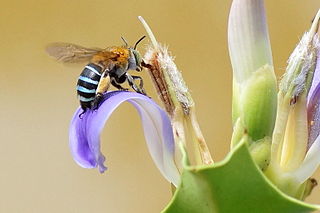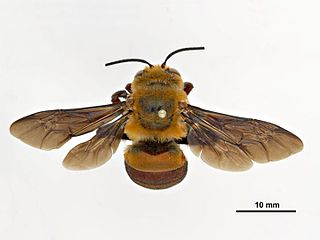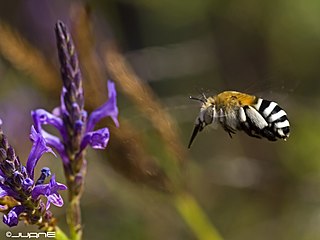
The Anthophorini are a large tribe in the subfamily Apinae of the family Apidae. Species in this tribe are often referred to as digger bees, although this common name is sometimes also applied to members of the tribe Centridini. It contains over 750 species worldwide, all of which were previously classified in the obsolete family Anthophoridae along with members of several other tribes; the vast majority of species in the tribe Anthophorini are in the genera Amegilla and Anthophora.

Australia has over 1,700 species of native bee. Bees collect pollen from flowers to feed their young. Flies do not do this, although they may be seen eating pollen, so identification is not always easy.

Amegilla is a large genus of bees in the tribe Anthophorini. Several species have blue metallic bands on the abdomen, and are referred to as "blue-banded bees". The genus occurs all around the world but very few live above 45° North.

Amegilla cingulata is a species of blue-banded bee native to Australia. Currently, several scientific organizations are conducting research on how A. cingulata benefits agriculture through its distinctive "buzz pollination".

Phalaenopsis pulcherrima is a species of orchid found from Hainan Island to western Malesia.

Amegilla bombiformis, commonly known as the teddy bear bee or golden haired mortar bee, is an Australian native bee in the family Apidae.

Amegilla dawsoni, sometimes called the Dawson's burrowing bee, is a species of bee that nests by the thousands in arid claypans in Western Australia. It is a long tongued bee, of the tribe Anthophorini and genus Amegilla, the second largest genus in Anthophorini.

Amegilla quadrifasciata, the white-banded digger bee, is a species of bee belonging to the family Apidae subfamily Apinae.

Thyreus lugubris, is a species of Australian native bee belonging to the family Apidae subfamily Apinae.
Amegilla confusa, is a species of bee belonging to the family Apidae subfamily Apinae.
Amegilla violacea is a species of bee belonging to the family Apidae subfamily Apinae.
Amegilla mucorea, is a species of bee belonging to the family Apidae subfamily Apinae.
Amegilla fallax is a species of bee belonging to the family Apidae subfamily Apinae.
Amegilla cingulifera, is a species of bee belonging to the family Apidae subfamily Apinae.
Amegilla comberi, is a species of bee belonging to the family Apidae subfamily Apinae.
Amegilla niveocincta, is a species of bee belonging to the family Apidae subfamily Apinae.

Amegilla asserta is a species of bee endemic to Australia, belonging to the family Apidae subfamily Apinae. Females forage by performing buzz pollination.

Amegilla zonata is a species of blue-banded bees belonging to the family Apidae, widely distributed in Southeast Asia, where it is often confused with the Australian species Amegilla cingulata.

Amegilla canifrons, the Canary islands Blue-banded bee is a species of bee, belonging to the family Apidae. The species is endemic to Canary Islands.











